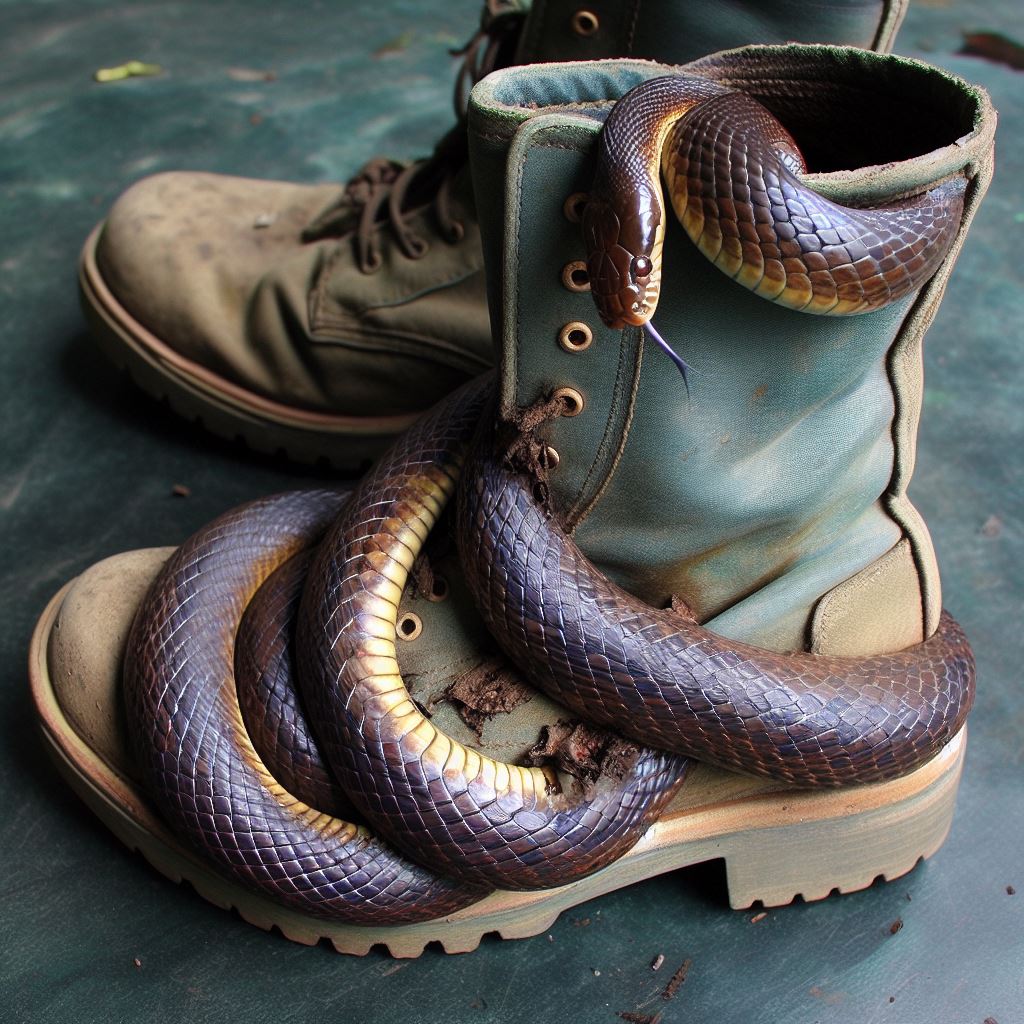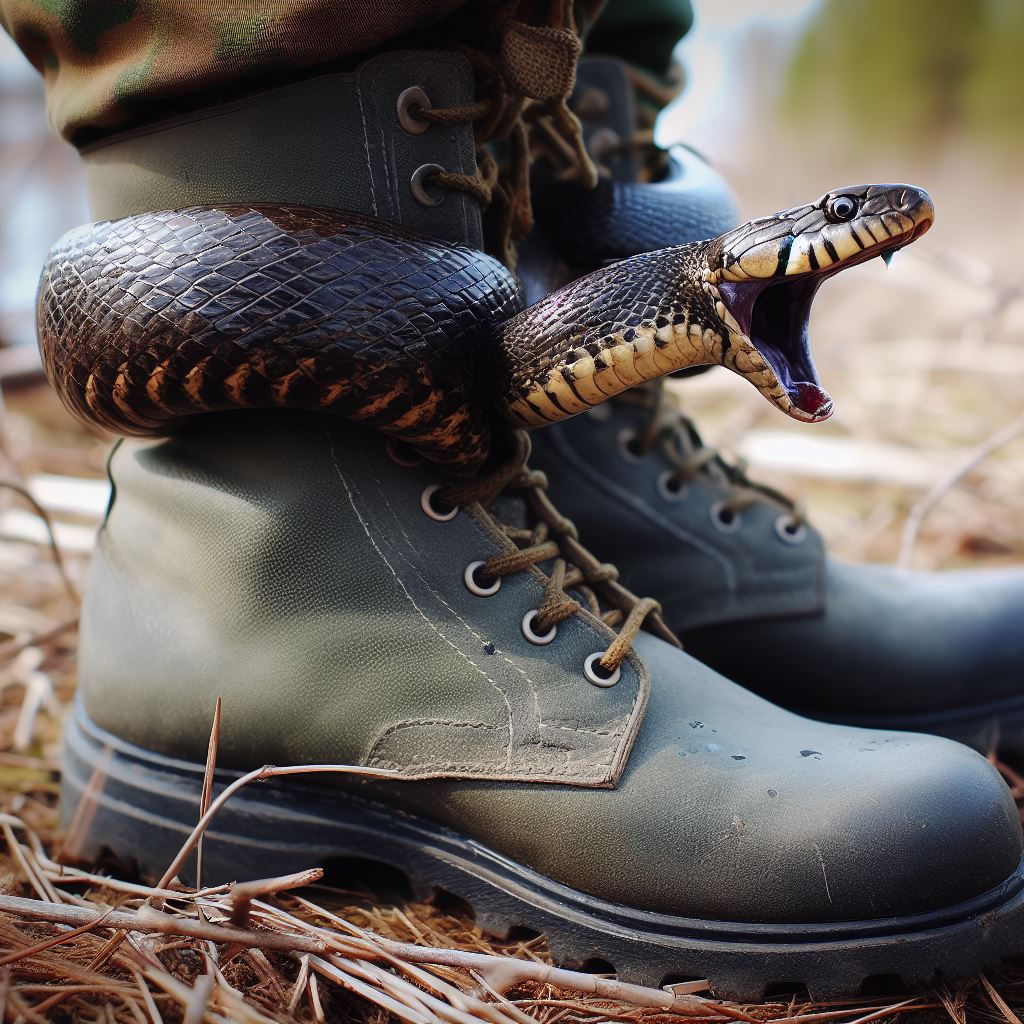As an avid hiker and outdoor enthusiast, I’ve had my fair share of encounters with snakes on the trail. And that got me wondering – can snakes actually bite through rubber boots? As useful as my trusty hiking boots are, could they really protect my feet and ankles if I accidentally stepped on an angry snake?
I did some digging to find out. And the short answer is yes, venomous snakes can potentially bite through rubber boots under the right circumstances. Their fangs are designed to penetrate flesh and inject venom deep below the skin’s surface. So a direct bite to an unprotected ankle or foot is extremely dangerous, even if you’re wearing fairly sturdy footwear.
That said, rubber boots do provide an extra layer of protection compared to shoes or low cut boots. Thick rubber makes it more difficult for fangs to fully penetrate to the skin. So while snake bites through boots are possible, your boots might also prevent the fangs from going deep enough to inject a lethal amount of venom.
To better understand when and how snakes can bite through boots, I wanted to research things from the snake’s perspective. What physical capabilities allow venomous snakes to potentially penetrate boot materials? And what motivates them to strike in the first place? Knowing more about snake behavior, strike positioning, and fang structure helps reveal if, how, and when rubber boots are vulnerable.
Factors That Allow Snakes to Bite Through Rubber Boots

Several key factors determine if a snake can successfully bite and envenomate someone through rubber boots in an attack, including:
Snake Species and Size
- Larger snakes tend to have longer fangs, enabling them to strike deeper. Massive constrictors can’t envenomate, but could potentially bite through boots with their teeth.
- Highly venomous snakes like rattlesnakes, copperheads, and cottonmouths have the most concerning bite risk, as even small amounts of venom can be medically significant.
Fang Length and Shape
- Fang tips are shaped almost like hypodermic needles – perfect for penetrating flesh and injecting venom.
- Fangs may reach over half an inch in length. Given the right strike angle, this is long enough to pass through boot materials.
Strike Trajectory
- Snakes strike with immense force, amplifying fang penetration power. Combine fang length and trajectory, and fangs could theoretically pass fully through a boot.
- Strikes to the foot or ankle area have the highest probability of envenomation. Upper calf or knee strikes are less likely to fully penetrate boot shafts.
Boot Material and Structure
- Natural rubber boots tend to be softer and more pliable than synthetic fabrics. This allows fangs to penetrate more easily compared to tough woven synthetics.
- Boots with air pockets, mesh fabric, or perforations also have higher risk of fang penetration.
So in summary, while rubber boots provide substantial snake bite protection compared to shoes or low cut hiking boots, they are not 100% impervious to determined snake strikes under the right conditions. Next let’s look at why snakes strike, and when they are most likely to target legs and feet.
Why Snakes Bite – Understanding Snake Strike Motivation
Snakes generally only bite for one of two reasons:
1. Feeling Threatened – Most snake bites happen when the snake feels threatened and acts defensively. Given their relatively small size, snakes rely on venom and bluff strikes to fend off potential predators. Boots or not, accidentally threatening a snake puts you at high risk of getting bitten.
2. Hunting Prey – Alternatively, bites may happen if a snake accidentally mistakes a human for prey. This is rare, but could conceivably lead to investigative or defensive bites targeting feet and legs.
Within these two categories, what are the most likely scenarios that could cause a snake to target boot-clad feet and ankles?
Accidentally Provoking or Threatening a Snake
Stepping on or near a snake is arguably the #1 trigger for defensive bites. And since our feet and legs cover the most ground while hiking, boots regularly invade snake territory – often without us realizing it. Specific accidental threat scenarios could include:
- Stepping directly on top of a snake
- Startling a snake while it’s coiled or at rest
- Blocking a snake’s presumed escape route
- Approaching a snake too closely
In all cases, the snake fears attack and defensively bites boots or clothing to discourage approach. Boots provide some protection, but you’re still likely to experience at least a strike or probing bite.
Investigation or Mistaken Identity Bites
Snakes have poor eyesight, relying heavily on scent, vibration, and heat to assess threats versus prey. Cases of “mistaken identity” aren’t unheard of. Situations where snakes might investigate or accidentally bite boots thinking they’re food include:
- Following a boot’s scent trail that resembles prey
- Striking at boot movement reminiscent of small fleeing prey
- Biting boots after picking up prey-like heat signatures
These cases are rarer, but illustrate the importance of making noise and staying alert on snake country trails. Paying attention helps avoid surprise encounters.
Now that we’ve covered snake motivations and likely strike scenarios, next I’ll examine strike postures and fang orientation. Understanding how snakes position their fangs before and during strikes shows how boots either protect us or leave us vulnerable depending on circumstances.
Snake Bite Mechanics – Fang Orientation Matters
Beyond environmental factors, a snake’s physical attributes and approach trajectory dictate its ability to successfully bite through boot materials. Specifically:
Fang orientation – The angle of the fangs relative to boot surfaces determines penetration potential.
Strike trajectory – The snake positions itself to align fangs perpendicular to target, maximizing penetrating power.
Strike force – Muscles rapidly accelerate fangs downward with great force, enabling the fangs to pass through materials not typically considered bite-proof.
Let’s look at some examples comparing protected strikes vs higher risk strikes based on fang orientation and trajectory:
| Strike Scenario | Fang Orientation | Risk Level |
|---|---|---|
| Side strike to boot shaft | Fangs perpendicular to boot surface | Low risk – Glancing blow unlikely to penetrate significantly |
| Strike to underside of boot | Fangs nearly parallel to boot – limited penetration angle | Medium risk – Some envenomation possible |
| Vertical strike to foot or ankle | Fangs completely perpendicular – ideal penetration trajectory | High risk – Maximum potential for envenomating bite |
As shown above, the most dangerous snake bites orient fangs directly into boot materials and feet. Fangs injecting straight downward into feet and ankles can more easily penetrate deep to skin surfaces underneath.
Just one more topic remains unanswered. Given variables of fang length, trajectory, penetration angle and more – can we definitively answer…
Can Snakes Bite Through Rubber Boots? Conclusive Analysis.
In summary – Yes, snakes absolutely can and do bite through rubber boots under the right conditions.
Boots grant a level of protection from bites that shoes and low cut footwear cannot. But they cannot be considered reliably “snake proof” given variables like:
- Penetration Angle – Ideal vertical strikes to feet/ankles align fangs perfectly perpendicular to boot surfaces for maximum penetrative force.
- Snake Size – Larger snakes may have fangs over half an inch long – enough to fully pierce boot materials.
- Trajectory Impact Force – Snake fangs strike with immense downward acceleration force, enabling penetration of surprisingly thick materials.
- Boot Composition – Natural rubber boots are somewhat more vulnerable to strikes compared to tough woven synthetic fabrics.
So while bites through boots won’t happen in 100% of strikes, they occur frequently enough that boots should not be considered impervious snake barriers. As a trail hiker, I personally opt for synthetic hiking-specific boots. But I still take precautions.
Precautions When Hiking in Snake Territory
To avoid snake bites even when wearing decent boots:
- Stay on designated trails – avoid potential snake havens like tall grass, downed trees, etc.
- Step ON logs/rocks – don’t step over them blindly.
- Look before putting hands/feet anywhere.
- Carry a hiking stick – probe suspicious areas ahead of steps.
- Stay quiet – don’t surprise snakes around the next bend.
- Wear gaiters/tall hiking socks – eliminate gaps between boots & pants.
Following these simple precautions greatly reduces your odds of getting bitten. And if you do receive a strike, wearing quality boots should dramatically limit venom injection/injury – buying you precious time to get medical treatment immediately.
So enjoy your adventures in snake country – just bring reliable foot protection and hike smart!

More Stories
6 Inch vs 8 Inch Boots: A Comprehensive Guide for Boot Enthusiasts
The Top 8 Best Hunting Boots for Saddle Hunting in 2024
Hiking Boots vs Hunting Boots: How to Decide Between the Two for Your Needs